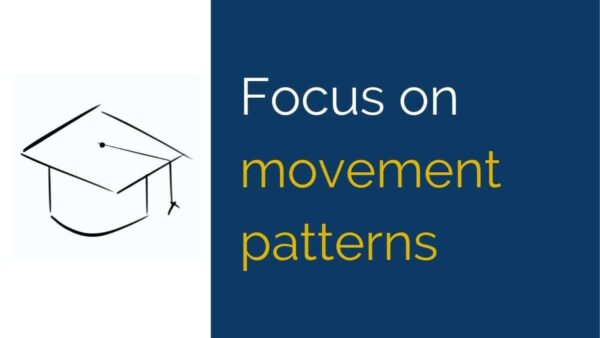Movement patterns are everywhere – it’s the way we walk down stairs, the way we open a door and who could forget the famous “sit to stand” pattern that we all memorised in 1st year uni.
Movement pattern cues are the little verbal prompts that a Physio or personal trainer uses to correct technique and improve movement patterns.
Tips like “drive your hip forward” or “force your heels down”, designed to help the patient visualise the focus of the movement pattern.
We’re trying to change the way the client’s brain coordinates the movement, adjusting its emphasis for a better outcome/performance.
It achieves this by tweaking the brain’s complex coordination of muscles, improving the timing or recruitment of certain muscles.
When we look at muscle patterns using EMG, we find fairly consistent patterns of millisecond-perfect firing of muscles.
This is true for basic movements like sitting down as much as complex movement patterns like running.
(If you want to challenge yourself on running-specific clinical knowledge, try our running clinical quiz here).
Every movement is made up a 10+ EMG maps of muscles, all working together in the precise timing to generate a movement.
But that’s not how the conscious part of the brain does it – the brain we talk to works on broad movement goals like “swing” or “force”.
That broad movement is then converted into muscle patterns somewhere in the grey matter, not in the conscious part of the brain.
So trying to change a motor pattern by “manually” adjusting a muscle is ineffective and worsens performance.
Effective prompts for movement patterns
The key to an effective prompt is it has to match the framework that your patient’s brain already uses.
Some brains will resonate with the concept of pushing a step down, in order to generate drive walking up stairs.
Others will think about lifting their body while some will work best with focusing on straightening their knee.
The point here is that everyone’s brains and thought processes are different.
This means that there will be some trial and error while you test different prompts to see what’s effective for your client..
The true test of an effective movement pattern prompt is that it should reduced effort or produce greater output, or both.
Simply reciting the same prompt for everyone doesn’t account for differences in the way we all think.
So try to have a few common prompts for all movement patterns, but be ready to adapt those prompts if they’re not yielding results.
If you’re stuck, demonstrate the technique to the patient and ask them to describe what they’re seeing – it often gives hints as to how they visualise movement patterns.
Ineffective prompts for movement patterns
Remember that correct muscle firing patterns are millisecond-specific – trying to override this with deliberate control is a common mistake.
This is because your conscious brain doesn’t think about individual muscles, it thinks “push forwards” or “straighten leg”.
The firing patterns are subconscious, so you can’t override that programming by deliberately squeezing a certain muscle.
The unintended consequence of deliberate muscle control is to disrupt the movement pattern.
This makes it less efficient and less effective.
So an ineffective prompt is to “squeeze your glutes” or “activate your core”.
There is no carry-over effect to the function or the automated motor pattern so the benefit seems to be primarily to make the Physio feel better…
Implement this!
When you’re correcting or optimising a technique, whether it’s an ADL, exercise or workplace task, remember:
- Prompt with actions, not deliberate clenching
- Try different prompts for effectiveness
- Ask the patient for their description if you’re stuck
- Monitor the output of a patient’s movement patterns for improvement after each prompt

